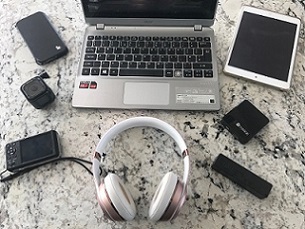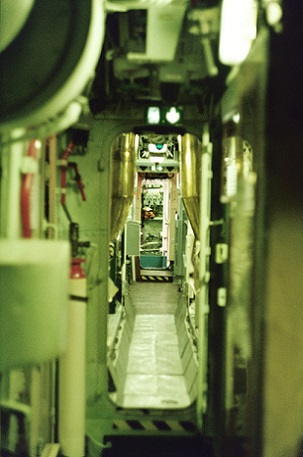 Passengers take all kinds of battery-powered devices on board tourist marine craft. Image from free photo website Pixabay.
Passengers take all kinds of battery-powered devices on board tourist marine craft. Image from free photo website Pixabay.
 A pilot holding an AvSax lithium battery fire containment bag
A pilot holding an AvSax lithium battery fire containment bag
 All these everyday devices are powered by lithium-ion batteries
All these everyday devices are powered by lithium-ion batteries
 Inside a submarine. Photo from Taylor Vatem on free photo website Unsplash
Inside a submarine. Photo from Taylor Vatem on free photo website Unsplash
Thousands of people now go on trips in tourist submarines and submersibles worldwide every year and take with them cameras and other devices powered by lithium batteries.
But there is always the danger the batteries could overheat or even catch fire in a lightning quick process called thermal runaway, filling the underwater craft with toxic smoke.
An ideal solution is the AvSax thermal fire mitigation bag – sometimes called a burnbag – which is designed to contain the device and quickly solve what could otherwise become a very serious problem.
They were invented for use in the confined space of aircraft passenger cabins and have been used in action at least 33 times since the start of 2017, but probably a lot more.
AvSax are now on board more than 100 airline companies operating 16,770 aircraft worldwide – including some of the biggest names in the industry. AvSax are the most widely deployed battery burnbags on aircraft by far and won the Queen’s Award for Enterprise in the UK for their innovation which is the highest award any business can get.
AvSax thermal containment bags are made from military grade material and are unique in that they are designed to continually cool the overheating battery by adding water into the bag once the device has been put in there.
They were invented by Environmental Defence Systems Ltd based in Huddersfield, Yorkshire, England.
Managing director Richard Bailey said: “We know the AvSax have been used in action 33 times but there will be many other incidents where they have been used yet the airline may not have let us know.
“No-one wants a fire in an aircraft passenger cabin and the space in tourist submarines and submersibles will be far smaller so the potential for a serious incident there is even more acute with the potential for a catastrophe.
“Lithium battery fires are very dangerous as they can continue to burn even when starved of oxygen and can flare up again even when you think they’ve been extinguished.
“That’s why it’s vital that owners of these craft are fully prepared if this should happen and need to have safety measures in place. After all, tourists often come with lots of personal electronic devices such as cameras, mobile phones and iPads, all powered by lithium ion batteries.
“Strangely, the largest cause of lithium battery fires on aircraft in American airspace is batteries used to power vapes. Even though passengers aren’t allowed to use vapes on aircraft the batteries can be quite volatile and suddenly catch fire.”
There are more than 30 tourist submarines in the world and most subs don’t go much deeper than 400 metres which is 1,312ft or just under a quarter-of-a-mile.
The difference between a submarine and a submersible is that a submersible is an underwater craft which needs to be transported and supported by a surface vessel while submarines are self-powered and self-supporting.
During thermal runaway lithium batteries can produce heat up to 900°C (1652°F) making it very difficult to extinguish, especially as it doesn’t need oxygen to keep flaring up even to the point of exploding. AvSax are designed to withstand the force of a blast once the device is in there. Every time there has been a problem with a device and it has been placed in an AvSax the aircraft has landed safely.
The danger has been brought into focus with the number of fires on passenger aircraft caused by lithium batteries overheating, smouldering, catching fire or even exploding on board. Up to the start of June 2023, the Federal Aviation Administration (FAA) in the USA has recorded 446 aviation-related incidents involving lithium batteries carried as cargo or baggage since January 23, 2006. Many more incidents will have happened in other parts of the world as the FAA only covers US aircraft and incidents in US airspace and figures for lithium incidents in UK airspace and other parts of the world are not made public.